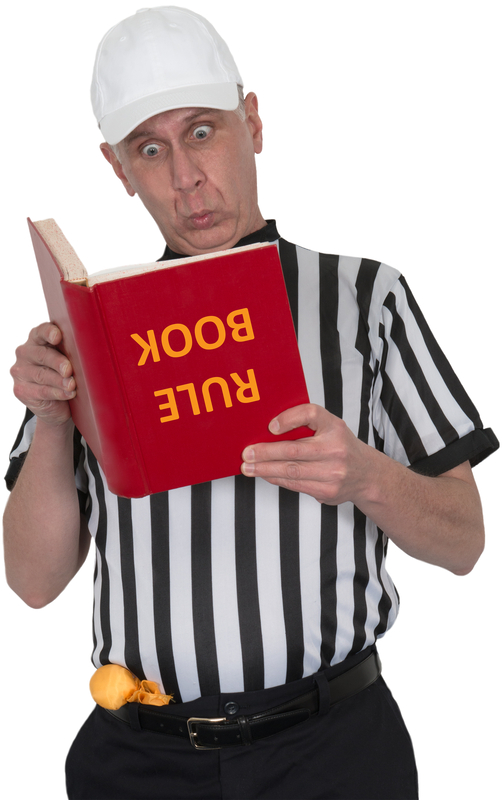The Four Most Confusing Rules in Sport, Explained

A good game requires good rules. And the first rule of rule-making is keep it logical. That's where the trouble starts. Tweet

Highlights
Without rules, there's no game. Just guys in funny clothes on a big lawn.
So rules make the game. And sometimes, they make the game impossible to understand.
I’ve been obsessed with baseball my entire life.
In fact, some of my earliest and fondest childhood memories are of throwing, hitting, and trying to catch a rubber ball in the yard with my parents and siblings.
Alas, that was my peak as a ballplayer.
But as much as I loved baseball (unrequited love, but still), I didn’t actually know the rules of the game until I started umpiring youth league games as a teenager.
The hardest one to understand, by far, is the infield fly rule. I’ll explain what it is in a minute, along with a bizarre application that literally ended the season for a Major League Baseball team.
Every major sport has at least one rule that bewilders even the most passionate fans. We’re not talking about arcane clauses and footnotes, the athletic equivalent of nineteenth-century municipal ordinances against spitting on the sidewalk.
These are the odd rules that can change the outcome of games, seasons, and careers.
These are important rules that, when enforced (or not), can change the outcome of games, seasons, and careers.
Baseball:
Infield fly rule
An infield fly is a fair fly ball (not including a line drive nor an attempted bunt) which can be caught by an infielder with ordinary effort, when first and second, or first, second and third bases are occupied, before two are out.
When a batter hits a pop-up in that situation, the umpire immediately calls them out, while the ball is still in the air. That prevents a fielder from deliberately dropping the ball and starting a double or triple play.
Most of the time, it’s an uncontroversial call. But look at this clause in the fine print: “…can be caught by an infielder with ordinary effort.”
What constitutes “ordinary effort”? Ordinary for whom?
Nor is it limited to the infield, or even to infielders. An ump can invoke the infield fly rule in the outfield, on a ball that’s played by an outfielder, if in their judgment an infielder could have caught it with “ordinary effort.”
And because it’s a judgment call, it can’t be appealed or reviewed.
Here’s the most famous (mis)application of the infield fly rule. It was the key play in the 2012 wild card game that knocked the Braves out of the playoffs:
Basketball:
Traveling
Traveling should be a straightforward call: If the player with the ball takes more than two steps without dribbling or shooting, it’s a violation, and possession goes to the other team.
But in the NBA, a player is given an extra move, called a “gather step.” To anyone watching, including the players, it looks like four steps:
1. The player “gathers” the ball to gain control (step one)
2-3. Takes two steps toward the basket (steps two and three)
4. Then pushes off to launch a shot (step four)
When someone with a limb the length of a pro basketball player takes those four steps, it looks like a running back blasting up the middle for a touchdown. What it’s not, in the eyes of the officials, is traveling.
Football:
Pass interference
Every football fan understands what pass interference is: It’s when the guy on your team fails to make a catch because of something a guy on the other team did.
Of course, that’s not the definition you find in the rules: “It is pass interference by either team when any act by a player more than one yard beyond the line of scrimmage significantly hinders an eligible player’s opportunity to catch the ball.”
But good luck finding any consistent application of the rule. NFL refs are famous for not calling pass interference at crucial moments in key games.
Replay doesn’t help. According to fivethirtyeight.com:
“Only 24 of 101 replay reviews involving pass interference resulted in reversals [in the 2019] regular season. Instant reply had even less of an effect on plays when PI was called on the field; just three of 27 such reviews led to an overturn — and none of the 13 coach-initiated reviews overturned a PI call.”
So players and fans are stuck with a standard for pass interference that’s clear in theory but a Rorschach test in application.
Soccer:
Offsides
I played some soccer as a kid, but until I became a youth coach, I never knew the laws of the game. (Yes, they’re called “laws,” not “rules.”) It’s something I highly recommend for coaches, parents, and fans. There’s bound to be something in there you didn’t know.
For fans of American football, the hardest of them all is Law 11: Offside:
A player is in an offside position if:
Any part of the head, body or feet is in the opponents’ half (excluding the halfway line), and
Any part of the head, body or feet is nearer to the opponents’ goal line than both the ball and the second-last opponent
Since the goalie is almost always the last opponent, the “second-last opponent” is the defender who’s closest to the goal.
It’s not a penalty to be in an offsides position. It only matters if you’re past that defender at the moment your teammate passes the ball to you.
For fans of American football, it’s completely counterintuitive to call someone offsides for getting behind the defenders to receive a pass. It’s one of the most exciting plays in the game. But in Association Football, aka soccer, it’s a penalty.
Even when you understand the concept of the rule, you still have no sense of how hard it is to see the penalty during live action. Your eyes are fixed on the player with the ball. You follow the ball as it’s passed, and you see it go to a player who’s gotten behind the defenders.
What you often can’t see in that sequence is where the target of the pass was in relation to their defender at the moment it came off their teammate’s foot. If they were between the defender and the goal, it’s offsides. If the defender was closer to the goal, it’s a legal pass.
You have to hope—as a player, coach, parent, or fan—that the referee was looking in the right place at the right time to make the right call. But without instant replay, you can’t really know. Even at the highest levels of professional soccer, where they have a sideline referee to make that call and instant replay to ensure they get it right, it’s sometimes so close it could’ve gone either way.
And sometimes the ref just blows it, like in this 2010 World Cup match between the U.S. and Slovenia:










